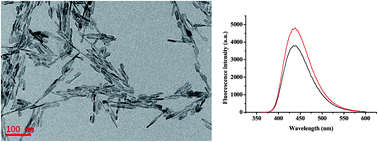Selective turn-on detection of low levels of cysteine and homocysteine based on fluorescent hydroxyapatite nanoparticles
Abstract
Fluorescent hydroxyapatite nanoparticles (HAP-NPs) were synthesized by introducing trisodium citrate during the HAP-NP synthesis process. The HAP-NPs display strong emission at around 440 nm when excited at 340 nm. In the presence of low levels of biothiols, such as cysteine (Cys) and homocysteine (hCys), the fluorescence intensity of HAP-NPs was found to be enhanced, while for the same concentration of glutathione (GSH), a smaller fluorescence intensity increase was observed. So a selective and sensitive fluorescence turn-on assay for detection of low levels of biothiols is reported. The linear range of the assay for Cys is from 2 to 100 nM, and for hCys is from 2 to 200 nM. The assay was successfully applied to the detection of Cys in human serum samples. The interesting fluorescence properties of HAP-NPs, plus their good biocompatibility, mean that HAP-NPs may find wide application as fluorescence probes in different assays and bio-imaging areas.

- This article is part of the themed collection: Analytical Methods Recent HOT articles


 Please wait while we load your content...
Please wait while we load your content...